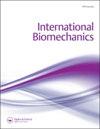Reactive balance to unanticipated trip-like perturbations: a treadmill-based study examining effect of aging and stroke on fall risk
Q2 Medicine
引用次数: 13
Abstract
ABSTRACT The purpose of this study was to examine the mechanism of fall risk in community-dwelling ambulatory hemiplegic stroke survivors when exposed to a sudden, trip-like support surface perturbation in standing. Participants (n = 14 / group) included stroke survivors, Age-similar older controls (AC), and Young controls (YC) experienced trip-like perturbation on a motorized treadmill. The primary outcomes were COM state control (measured as COM position (XCOM/BOS) and velocity (VCOM/BOS) relative to the base of support (BOS)) and the vertical limb support recorded as the extent of hip descent. All participants demonstrated forward loss of balance (FLOB) followed by an equal first compensatory step length. At step touchdown, stroke survivors demonstrated lower COM state stability and increased trunk flexion than the YC group. Stroke survivors also demonstrated greater hip descent than YC and AC groups, as they first stepped with their non-paretic limb. For the second compensatory step, the stroke survivors stepped with their paretic limb. However, unlike the AC group, they were unable to control VCOM/BOS despite a longer compensatory step. In conclusion, poor control of COM state, impaired trunk control and inability of the paretic limb to provide vertical limb support may explain the higher fall-risk in stroke survivors.对意外绊倒样扰动的反应性平衡:一项基于跑步机的研究,研究衰老和中风对跌倒风险的影响
摘要:本研究的目的是研究社区居住的非能动偏瘫中风幸存者站立时暴露于突然的绊倒样支撑面扰动时跌倒风险的机制。参与者(n = 14 /组)包括中风幸存者,年龄相似的老年对照组(AC)和年轻对照组(YC),他们在电动跑步机上经历了类似旅行的扰动。主要结果是COM状态控制(测量为COM位置(XCOM/BOS)和相对于支撑底(BOS)的速度(VCOM/BOS))和记录为髋关节下降程度的垂直肢体支持。所有参与者都表现出前向平衡丧失(FLOB),随后是相同的第一步补偿性步长。在台阶着地时,中风幸存者表现出较低的COM状态稳定性和较YC组增加的躯干屈曲。与YC组和AC组相比,中风幸存者在第一次使用非麻痹肢体时表现出更大的髋关节下降。在第二步补偿中,中风幸存者用他们的麻痹肢体行走。然而,与AC组不同的是,尽管有较长的补偿步骤,他们仍无法控制VCOM/BOS。综上所述,COM状态控制不佳、躯干控制受损以及瘫痪肢体无法提供垂直肢体支持可能是脑卒中幸存者摔倒风险较高的原因。
本文章由计算机程序翻译,如有差异,请以英文原文为准。
求助全文
约1分钟内获得全文
求助全文
来源期刊

International Biomechanics
Medicine-Rehabilitation
CiteScore
1.90
自引率
0.00%
发文量
2
审稿时长
17 weeks
期刊介绍:
International Biomechanics is a fully Open Access biomechanics journal that aims to foster innovation, debate and collaboration across the full spectrum of biomechanics. We publish original articles, reviews, and short communications in all areas of biomechanics and welcome papers that explore: Bio-fluid mechanics, Continuum Biomechanics, Biotribology, Cellular Biomechanics, Mechanobiology, Mechano-transduction, Tissue Mechanics, Comparative Biomechanics and Functional Anatomy, Allometry, Animal locomotion in biomechanics, Gait analysis in biomechanics, Musculoskeletal and Orthopaedic Biomechanics, Cardiovascular Biomechanics, Plant Biomechanics, Injury Biomechanics, Impact Biomechanics, Sport and Exercise Biomechanics, Kinesiology, Rehabilitation in biomechanics, Quantitative Ergonomics, Human Factors engineering, Occupational Biomechanics, Developmental Biomechanics.
 求助内容:
求助内容: 应助结果提醒方式:
应助结果提醒方式:


